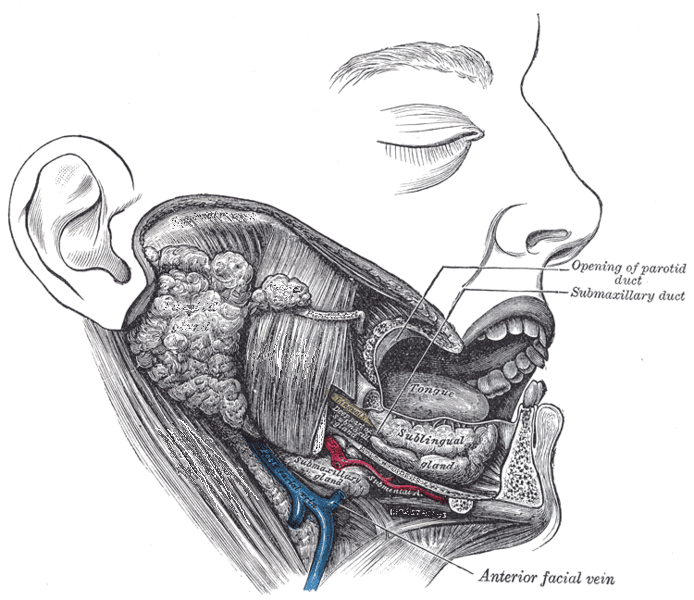This article outlines the symptoms and treatment of an obstructive swelling of the salivary glands. Treatment for salivary gland stones may not be necessary as these often pass with time but surgery can be used in some cases.
Blocked Salivary Glands - Contents
- What are the salivary glands?
- How many salivary glands are there?
- What are obstructive symptoms?
- What causes obstructive symptoms?
- How are salivary gland stones treated?
- Surgical treatment for salivary gland stones
- Prevention of salivary gland stones
What are the salivary glands?
The salivary glands are glands in the head and neck that produce saliva. The saliva is secreted along tube-like ducts into the mouth. The glands also help digestion by producing an enzyme called amylase that breaks down starch into maltose.
How many salivary glands are there?
Salivary glands are divided into major and minor glands.
- As their name suggests the minor glands are small (just a few millimetres in diameter). There are over 600 minor salivary glands located throughout the lips, mouth and throat that mainly secrete mucus and so aid the coating and lubrication of these structures.
- There are six major salivary glands - the parotid, submandibular and sublingual glands. These major glands are paired structures with three lying on either side of the head and neck. The parotid is the largest salivary gland and lies immediately in front of the ear, extending downwards towards the lobe. It expresses saliva through a duct that opens into the mouth opposite the upper molar teeth. The submandibular glands lie in the upper part of the neck just in front of the angle of the lower jaw. They secrete saliva through a duct that opens immediately behind the lower incisor teeth. Even though the submandibular glands are much smaller than the parotid glands they produce approximately 70% of saliva. The sublingual glands are located beneath either side of the tongue and they produce less than 5% of saliva.

What are obstructive symptoms?
If the normal flow of saliva through the ducts into the mouth is obstructed, symptoms occur. Typically these involve swelling of the glands. This swelling is intermittent in nature, and commonly occurs in and around eating (so called “meal time syndrome”). The swelling is often painful.
What causes obstructive symptoms?
Stones (also called calculi) can form in the major salivary glands and their ducts, causing obstruction to salivary outflow. Stones are most commonly seen in the submandibular gland but may also occur in the parotid. Obstruction is less common in the parotid gland as its secretions are more watery and the duct is wider. The sublingual glands drain into the mouth through between 10 and 20 ducts and so rarely obstruct. Obstructive symptoms may also occur because of mucus plugs within the duct. Rarely obstruction can be caused by a narrowing of the opening of the duct (stenosis). This can sometimes be secondary to chronic trauma.
How are salivary gland stones treated?
Many stones will pass spontaneously so conservative treatment is often tried in the first instance. This consists of gland massage to assist the passage of the stone. Gland function can be enhanced by the use of sialogogues – these are substances that promote the secretion of saliva, e.g. lemon juice. Although painkillers are sometimes required it is only rarely necessary to use antibiotics.
If stones fail to pass spontaneously then their position and number need to be identified. This can be aided by the use of plain x-rays (these tend to demonstrate submandibular stones better than parotid stones), sialography (the injection of dye into the salivary glands) or ultrasound.
Surgical treatment for salivary gland stones
Stones close to the opening of the ducts can be simply removed under local or general anaesthesia. Increasingly minimally-invasive techniques are employed such as endoscopy (the use of miniature telescopes to remove stones) or lithotripsy (the use of shockwaves to break up stones). Strictures can often be dilated with balloons under local anaesthesia.
Prevention of salivary gland stones
Those people who have had salivary gland stones are more likely to produce them again. Currently there are no evidence-based methods of prevention. Salivary gland stones are not more common in hard water areas nor do they tend to occur in individuals who have suffered either kidney stones or gallstones.






